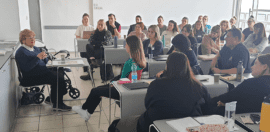New Data Reveals Picture of Disability, Aging and Carers in Australia

24 October 2016 at 9:47 am
Almost one in 12 Australians with disability – or more than 281,000 people – reported that they had experienced discrimination or unfair treatment because of their disability, according to new data from Australian Bureau of Statistics.
The figures were revealed in the latest survey data called Disability, Ageing and Carers, Australia: Summary of Findings.
The ABS 2015 statistics showed that young people with disability (aged 15 to 24 years) were more likely to report the experience of discrimination (20.5 per cent) than those aged 65 years and over (2.1 per cent).
Over one-third (35.1 per cent) of women and more than one quarter (28.1 per cent) of men aged 15 years and over had avoided situations because of their disability.
The survey findings showed that an employer was the source of discrimination for almost half of those aged 15 to 64 years with disability who were unemployed (46.9 per cent) or employed full-time (46.2 per cent) and just over one-third (34.6 per cent) of those employed part-time.
The ABS said the disability prevalence rate in Australia had remained relatively stable over time, with one in five people (18.3 per cent or 4.3 million) reporting a disability in 2015, and 18.5 per cent in 2012 and 2009.
The majority (78.5 per cent) of people with disability reported a physical condition, such as back problems, as their main long-term health condition. The other 21.5 per cent reported mental and behavioural disorders.
The release of the ABS data followed evidence given in a Senate estimates committee hearing from the Australian Human Rights Commission, which found disability discrimination received the highest level of complaints across the board to the commission.
Human Rights Commission president Gillian Triggs and disability commissioner Alistair McEwan told the hearing that disability complaints were on the rise and now made up the highest number of all complaints received, particularly around employment, and goods and services.
“The most recent percentages for complaints about discrimination in employment for people with disability is 35 per cent,” Triggs said in answer to questioning from Greens Senator Rachel Siewert.
“With goods and services it is at 33 [per cent]. So you can see we get to 68 per cent which pretty much reflects the kind of balance of the work of the commission.
“[The number] isn’t decreasing at all.”
The latest ABS survey looked at carers in Australia and found that the average age of a primary carer was 55 years.
In 2015, almost 2.7 million Australians were carers (11.6 per cent), with 856,100 people (3.7 per cent) aged 15 years and over identified as primary carers. These patterns were similar to those in 2009 and 2012.
Over one-third of primary carers (37.8 per cent) were living with disability themselves and women made up the majority of carers, representing 68.1 per cent of primary carers and 55.5 per cent of all carers.
For people aged 15 to 64 years, the labour force participation rate for primary carers (56.3 per cent) and other carers (77.2 per cent) was lower than for non-carers (80.3 per cent).
On the positive side the ABS figures showed that while the proportion of older Australians had increased, the prevalence of disability amongst older people had decreased.
And the ABS survey found older Australians had active social lives and were getting more exercise.
“The number of older Australians aged 65 years and over who participated in exercise or physical recreation increased from 44.5 per cent in 2012 to 49.2 per cent in 2015,” ABS program manager of health and disability statistics Justine Boland said.
“In 2015, 50.7 per cent of older people were living with disability, down from 52.7 per cent in 2012.”
In 2015, there were an estimated 3.5 million people aged 65 years and over, representing one in every seven people (15.1 per cent). This proportion has increased from 14.3 per cent in 2012 and 13.3 per cent in 2009.
The proportion of all older Australians who needed assistance with at least one activity has also decreased to 38.6 per cent in 2015, down from 41.9 per cent in 2012.
“These findings reveal a positive trend that older Australians are healthier, living longer without disability and are in less need of assistance,” Boland said.








